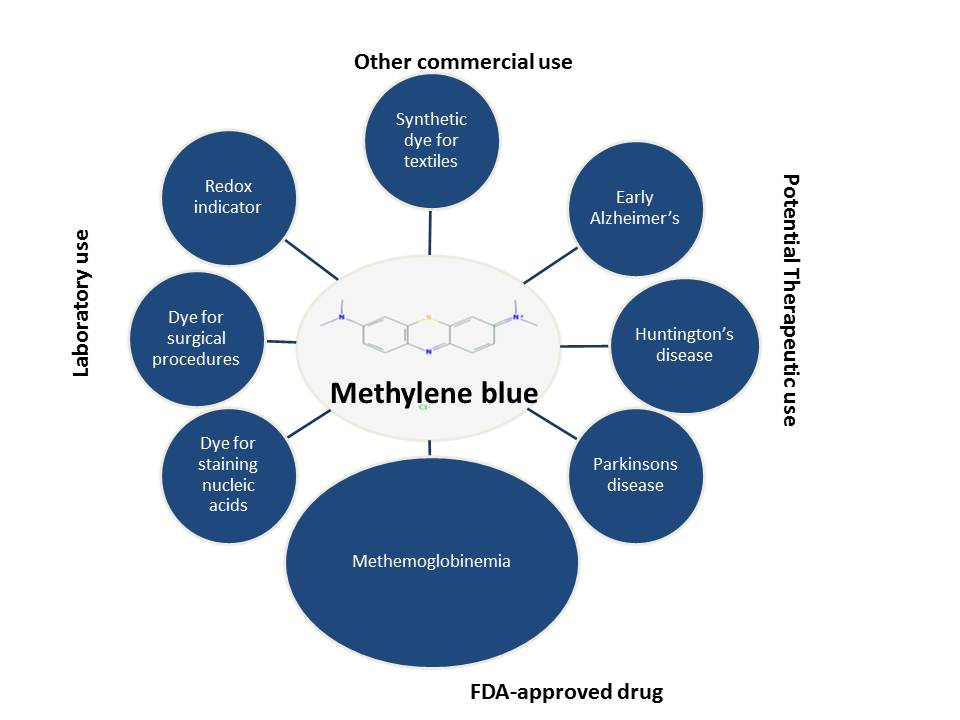Methylene Blue
Post in Progress: There’s so much misinformation on this substance regarding proper dosage, risks, and potential effects that I just wanted to create a page to collect all the human data on methylene blue for cognitive enhancement.
I’ll be updating it frequently as a I gather all the studies.

The Science
http://pubs.rsna.org/doi/10.1148/radiol.2016152893
Neuroradiology
Multimodal Randomized Functional MR Imaging of the Effects of Methylene Blue in the Human Brain
Pavel Rodriguez, MD , Wei Zhou, BS , Douglas W. Barrett, PhD , Wilson Altmeyer, MD , Juan E. Gutierrez, MD , Jinqi Li, MD , Jack L. Lancaster, PhD , Francisco Gonzalez-Lima, PhD , Timothy Q. Duong, PhD
Abstract
Purpose
To investigate the sustained-attention and memory-enhancing neural correlates of the oral administration of methylene blue in the healthy human brain.
Materials and Methods
The institutional review board approved this prospective, HIPAA-compliant, randomized, double-blinded, placebo-controlled clinical trial, and all patients provided informed consent. Twenty-six subjects (age range, 22–62 years) were enrolled. Functional magnetic resonance (MR) imaging was performed with a psychomotor vigilance task (sustained attention) and delayed match-to-sample tasks (short-term memory) before and 1 hour after administration of low-dose methylene blue or a placebo. Cerebrovascular reactivity effects were also measured with the carbon dioxide challenge, in which a 2 × 2 repeated-measures analysis of variance was performed with a drug (methylene blue vs placebo) and time (before vs after administration of the drug) as factors to assess drug × time between group interactions. Multiple comparison correction was applied, with cluster-corrected P < .05 indicating a significant difference.
Results
Administration of methylene blue increased response in the bilateral insular cortex during a psychomotor vigilance task (Z = 2.9–3.4, P = .01–.008) and functional MR imaging response during a short-term memory task involving the prefrontal, parietal, and occipital cortex (Z = 2.9–4.2, P = .03–.0003). Methylene blue was also associated with a 7% increase in correct responses during memory retrieval (P = .01).
Conclusion
Low-dose methylene blue can increase functional MR imaging activity during sustained attention and short-term memory tasks and enhance memory retrieval.
“Then, 13 participants (the methylene blue group) were randomized to receive 280 mg (approximately 4 mg/kg) of oral U.S. Pharmacopeia-grade methylene blue…”
https://www.ncbi.nlm.nih.gov/pubmed/26961091
Brain Imaging Behav. 2016 Mar 10. [Epub ahead of print]
Methylene blue modulates functional connectivity in the human brain.
Rodriguez P1,2, Singh AP3, Malloy KE4, Zhou W4, Barrett DW5, Franklin CG4, Altmeyer WB3, Gutierrez JE3, Li J4, Heyl BL4, Lancaster JL4, Gonzalez-Lima F5, Duong TQ6.
Author information
Abstract
Methylene blue USP (MB) is a FDA-grandfathered drug used in clinics to treat methemoglobinemia, carbon monoxide poisoning and cyanide poisoning that has been shown to increase fMRI evoked blood oxygenation level dependent (BOLD) response in rodents. Low dose MB also has memory enhancing effect in rodents and humans. However, the neural correlates of the effects of MB in the human brain are unknown. We tested the hypothesis that a single low oral dose of MB modulates the functional connectivity of neural networks in healthy adults. Task-based and task-free fMRI were performed before and one hour after MB or placebo administration utilizing a randomized, double-blinded, placebo-controlled design. MB administration was associated with a reduction in cerebral blood flow in a task-related network during a visuomotor task, and with stronger resting-state functional connectivity in multiple regions linking perception and memory functions. These findings demonstrate for the first time that low-dose MB can modulate task-related and resting-state neural networks in the human brain. These neuroimaging findings support further investigations in healthy and disease populations.
“At a low dose (1–4 mg/kg), MB can cross the blood-brain barrier and form a reversible reduction-oxidation system with auto-oxidizing capacity.”
“MB has redox recycling properties in that it acts as a renewable electron cycler and facilitates electron transfer in the mitochondrial electron transport chain by accepting electrons from NADH and transferring them to cytochrome c oxidase, bypassing complexes I-III.”
“Low-dose MB increased brain glucose uptake, oxygen consumption and evoked fMRI responses in the rat brain under normal and hypoxic conditions in vivo.”
“MB also has a long history of safe usage. Its pharmacokinetics, side effect profile, and contraindications of low-dose MB are well-known, and importantly, minimal in humans.”
“Twenty-eight participants were enrolled between September 2013 and December 2014, and randomized to 280 mg of oral USP grade methylene blue.”
“The 280 mg dose selection was estimated as a 4 mg/kg dose (for an average 70 kg body weight) because the hormetic property of MB has mitochondrial enhancing effects at the low-dose range of 0.5–4 mg/kg, and opposite negative effects at doses >10 mg/kg.”
https://www.ncbi.nlm.nih.gov/pubmed/25018057
Am J Psychiatry. 2014 Oct;171(10):1091-8. doi: 10.1176/appi.ajp.2014.13101407.
Effects of post-session administration of methylene blue on fear extinction and contextual memory in adults with claustrophobia.
Telch MJ, Bruchey AK, Rosenfield D, Cobb AR, Smits J, Pahl S, Gonzalez-Lima F.
Abstract
OBJECTIVE:
Preclinical studies have shown that low-dose methylene blue increases mitochondrial cytochrome oxidase activity in the brain and improves memory retention after learning tasks, including fear extinction. The authors report on the first controlled experiment to examine the memory-enhancing effects of posttraining methylene blue administration on retention of fear extinction and contextual memory following fear extinction training.
METHOD:
Adult participants displaying marked claustrophobic fear were randomly assigned to double-blind administration of 260 mg of methylene blue (N=23) or administration of placebo (N=19) immediately following six 5-minute extinction trials in an enclosed chamber. Retesting occurred 1 month later to assess fear renewal as indexed by peak fear during exposure to a nontraining chamber, with the prediction that the effects of methylene blue would vary as a function of fear reduction achieved during extinction training. Incidental contextual memory was assessed 1 and 30 days after training to assess the cognitive-enhancing effects of methylene blue independent of its effects on fear attenuation.
RESULTS:
Consistent with predictions, participants displaying low end fear posttraining showed significantly less fear at the 1-month follow-up if they received methylene blue posttraining compared with placebo. In contrast, participants displaying moderate to high levels of posttraining fear tended to fare worse at the follow-up if they received methylene blue posttraining. Methylene blue’s enhancement of contextual memory was unrelated to initial or posttraining claustrophobic fear.
CONCLUSIONS:
Methylene blue enhances memory and the retention of fear extinction when administered after a successful exposure session but may have a deleterious effect on extinction when administered after an unsuccessful exposure session.

32 Comments
Leave your reply.